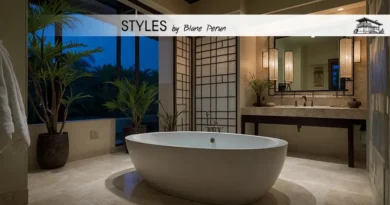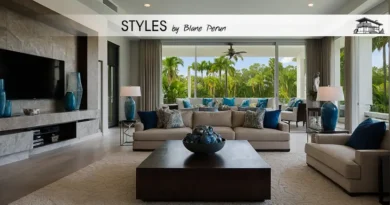Modern Style
Elevating Spaces: A Dive into Modern Home Interior Design
In the ever-evolving world of home decor, Modern Home Interior Design stands out as a beacon of innovation, blending functionality with aesthetic appeal. This design philosophy, characterized by minimalist layouts, natural light maximization, and a mix of natural and industrial materials, aims to create spaces that are not only visually appealing but also deeply connected to the inhabitants’ lifestyle and personality. As we delve deeper into this design paradigm, we’ll explore how it reshapes living spaces, making them more adaptable, aesthetically pleasing, and aligned with contemporary living standards.

The Essence of Minimalism in Modern Decor
Simplifying Spaces for a Clutter-Free Environment
In the realm of Modern Home Interior Design, minimalism isn’t just a trend; it’s the cornerstone of creating serene and uncluttered spaces. This approach emphasizes the ‘less is more’ philosophy, where every piece of furniture and decor is chosen with purpose and intention. By prioritizing functionality and simplicity, minimalism in modern interiors promotes a sense of tranquility and order, essential for today’s fast-paced lifestyle. The strategic use of clean lines, monochromatic color schemes, and unobtrusive furniture enhances the feeling of spaciousness, making minimalism not just a design choice but a way of living that celebrates the beauty of simplicity.
Embracing Negative Space as a Design Element
Negative space, or the area around and between objects, plays a pivotal role in Modern Home Interior Design. Instead of filling every nook and cranny with objects, modern designers leverage negative space to highlight the architectural features and essential elements within a room. This deliberate use of emptiness not only accentuates the room’s key components but also improves the overall flow and feel of the space. By treating negative space as an active design element, modern interiors achieve a balanced and harmonious aesthetic that resonates with the principles of contemporary design.
The Role of Technology in Contemporary Interiors
Smart Homes and Automated Systems
The integration of technology into Modern Home Interior Design transforms living spaces into intelligent ecosystems that respond to the inhabitants’ needs and preferences. Smart homes, equipped with automated systems for lighting, heating, security, and entertainment, exemplify how technology enhances the functionality and comfort of modern interiors. These technological advancements not only offer convenience but also contribute to energy efficiency and sustainability, aligning with the eco-conscious values prevalent in contemporary design philosophies.
Innovative Materials and Sustainable Solutions
Modern Home Interior Design often incorporates innovative materials and sustainable solutions, reflecting a growing awareness of environmental impact and the importance of durability. Materials such as bamboo, reclaimed wood, and recycled metals are increasingly popular for their sustainability and aesthetic versatility. These materials, combined with advanced manufacturing techniques, result in durable, low-maintenance, and eco-friendly interior elements that stand the test of time, both in style and substance.
Lighting and Color: Transforming Spaces
The Power of Natural Light
In Modern Home Interior Design, natural light is more than just a source of illumination; it’s a vital component that shapes the mood and atmosphere of a space. Large windows, skylights, and strategically placed mirrors are commonly used to maximize the influx of natural light, making spaces appear larger, more open, and more inviting. This emphasis on natural light not only enhances the visual appeal of interiors but also has psychological benefits, improving mood and productivity.
Color Palettes: Setting the Tone
The choice of color palette is crucial in Modern Home Interior Design, as it sets the tone for the entire space. Neutral tones, such as whites, beiges, and grays, dominate modern interiors, providing a versatile backdrop that complements the minimalist aesthetic. Accents of bold colors are often introduced through artwork, textiles, or statement pieces, adding depth and interest to the design. This careful selection of colors ensures that modern interiors remain timeless, allowing for easy updates and personalization without extensive redesigns.

Frequently Asked Questions
What makes Modern Home Interior Design unique?
Modern Home Interior Design is distinguished by its emphasis on simplicity, functionality, and the integration of natural and industrial elements. This design approach prioritizes clean lines, minimalist layouts, and the strategic use of space to create environments that are both aesthetically pleasing and highly functional. The incorporation of advanced technology and sustainable materials further enhances the comfort, efficiency, and environmental friendliness of modern interiors.
How can I incorporate modern design principles into my home?
Incorporating modern design principles into your home can start with embracing minimalism and decluttering your space. Focus on choosing furniture and decor that serve a purpose and complement the overall design theme. Incorporate natural light as much as possible and select a neutral color palette with occasional bold accents. Consider smart home technologies for added convenience and sustainability.
What role does color play in Modern Home Interior Design?
Color plays a pivotal role in Modern Home Interior Design by setting the mood and atmosphere of a space. Neutral tones dominate modern interiors, providing a clean and versatile backdrop. Bold accents are used sparingly to add depth and vibrancy. This thoughtful use of color ensures that modern interiors remain timeless and adaptable to individual tastes and trends.
How important is technology in modern interiors?
Technology is increasingly important in modern interiors, enhancing functionality, convenience, and sustainability. Smart home systems allow for the automation of lighting, temperature control, security, and entertainment, making daily life more efficient and comfortable. The use of innovative materials and sustainable solutions also reflects a modern commitment to environmental responsibility.
Can Modern Home Interior Design be both stylish and sustainable?
Yes, Modern Home Interior Design can be both stylish and sustainable. The use of eco-friendly materials, such as bamboo, reclaimed wood, and recycled metals, along with energy-efficient technologies, demonstrates how modern design principles prioritize environmental sustainability without compromising on style. These elements work together to create spaces that are not only visually appealing but also responsible and forward-thinking.





